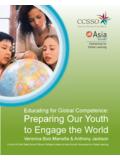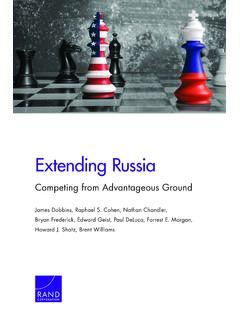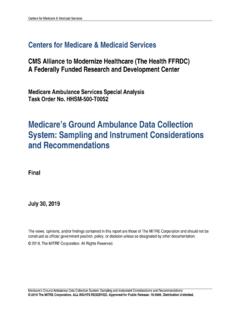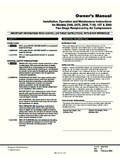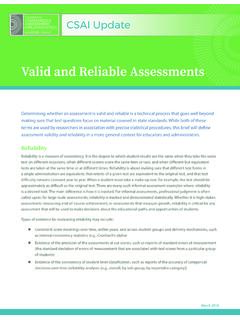Transcription of Teaching and Learning 21st Century Skills - Asia Society
1 Teaching and Learning 21st Century SkillsLessons from the Learning SciencesA GLOBAL CITIES EDUCATION NETWORK REPORT Teaching AND Learning 21st Century Skills : Lessons from the Learning Sciences rand corporation , April 2012 Anna Rosefsky Saavedra, rand corporation V. Darleen Opfer, rand corporation With many thanks to Tony Jackson, Jessica Kehayes, Jennifer Li, David Perkins, Heather Singmaster, and Vivien Stewart for their valuable suggestions. Teaching AND Learning - 2 FOREWORD Globalization of the economy, increasingly diverse and interconnected populations, and rapid technological change are posing new and demanding challenges to individuals and societies alike. School systems are rethinking the knowledge and Skills students will need for success and the educational strategies and systems required for all children to achieve them.
2 In both Asia and North America, urban school systems are at the locus of change in policy and practice at once the sites of the most-critical challenges in education and the engines of innovation needed to address them. Therefore, Asia Society organized the Global Cities Education Network, a network of urban school systems in North America and Asia, to focus on challenges and opportunities for improvement common to them, and to virtually all city education systems. A critical element of high-performing school systems is not only that they benchmark the practices of other countries but that they systematically adapt and implement these practices within their own cultural and political contexts. The Global Cities Education Network is intended as a mechanism for educators and decisionmakers in Asia and North America to collaboratively dream, design, and deliver internationally informed solutions to common challenges with which education systems are currently grappling.
3 The network engages in cycles of in-depth inquiry, planning, and action to address specific topics related to the themes of transforming Learning and achieving equity. Each cycle involves knowledge sharing and problem solving, including at Global Cities Education Network Symposia and the production of research and knowledge products, such as case studies, background papers, and meeting reports. The overarching goal is to develop practical wisdom from the research and experience of the world s leading experts that reflects proven or promising efforts in network cities and that can be used to enhance the effectiveness of network and city school systems worldwide. This report, prepared for the first Asia Society Global Cities Education Network Symposium, held in Hong Kong in May 2012, examines the current definitions of 21st Century Skills and looks at why and how they should be taught.
4 Asia Society is grateful to the authors, Anna Rosefsky Saavedra and V. Darleen Opfer of the rand corporation , for their support and assistance with the Global Cities Education Network. We would like to thank the sponsors of the Global Cities Education Network, including JPMorgan Chase Foundation, MetLife Foundation, Carnegie corporation , Pearson Foundation, and Hewlett Foundation. We hope that this series of reports provides knowledge and experience useful to cities in Asia, North America, and elsewhere eager to create the conditions that will promote success for all students in today s interconnected world. Tony Jackson Vice President, Education Asia Society Teaching AND Learning - 3 CONTENTS Introduction.
5 4 Defining 21st Century Skills .. 4 Why Students Need 21st Century Skills .. 6 Why Are Many Students Not Learning 21st Century Skills ? .. 7 How to Teach 21st Century Skills : Nine Lessons from the Science of Learning .. 8 1. Make It Relevant .. 8 2. Teach Through the Disciplines .. 9 3. Simultaneously Develop Lower- and Higher-Order Thinking Skills .. 10 4. Encourage Transfer of Learning .. 11 5. Teach Students to Learn to Learn .. 13 6. Address Misunderstandings Directly .. 14 7. Understand That Teamwork Is an Outcome and Promotes Learning .. 15 8. Exploit Technology to Support Learning .. 16 9. Foster Students Creativity .. 17 Science of Learning Lessons as 21st Century Skills .. 18 Assessing 21st Century Skills .. 18 Formative and Summative Assessments.
6 18 Examples of 21st Century Assessments .. 19 Meeting the 21st Century Assessment Challenge .. 20 Building the Capabilities to Teach 21st Century Skills .. 20 Effective Professional Development Is Critical .. 21 Schools, as Organizations, Must Support Teachers Professional Development .. 22 Schools Must Become Learning Organizations .. 22 Moving School Systems Toward 21st Century Education .. 23 References .. 24 Teaching AND Learning - 4 INTRODUCTION Preparing students for work, citizenship, and life in the 21st Century is complicated. Globalization, technology, migration, international competition, changing markets, and transnational environmental and political challenges add a new urgency to develop the Skills and knowledge students need for success in the 21st Century context.
7 Educators, education ministries and governments, foundations, employers, and researchers refer to these abilities with terms that include 21st Century Skills , higher-order thinking Skills , deeper Learning outcomes, and complex thinking and communication Skills . Interest in these Skills is not new. For example, for more than 40 years, researchers at Harvard University s Project Zero have been studying how students learn and how to teach these Skills . In this paper, we focus on what research tells us about how students learn 21st Century Skills and how teachers can effectively teach them. Although all countries believe that the knowledge and Skills that students need in the 21st Century are different from what they have needed in the past, terminology differs between countries, as does the emphasized composition of knowledge, Skills , and values.
8 We use the term 21st Century Skills because we believe that it is currently the most widely recognized and used term internationally, though we could just as easily substitute any of the previously mentioned terms for 21st Century Skills . Critics denounce the term for being vague and overused,1 for endorsing the idea of Teaching Skills apart from knowledge, and for promoting Skills that have been encouraged for centuries yet are now emphasized with a new sense of urgency that could lead to rapid and unsuccessful In the following sections, we briefly summarize current efforts to define 21st Century Skills and explain the economic, civic, and global rationales for why they are important. We attend to the criticisms leveled against 21st Century Skills by examining why these Skills must be taught primarily through disciplinary content, taking care not to trivialize subject matter 3 and then identifying specific ways to do so.
9 The majority of the paper thus focuses on explaining how these Skills should be taught, given what we know about how students learn. We then discuss the assessment of 21st Century Skills and conclude with an overview of the teacher capacity implications of institutionalizing new Teaching and Learning processes. DEFINING 21st Century Skills There is no shortage of current definitions of 21st Century Skills and knowledge. In this paper, we do not seek to provide another or choose one over another. Rather, we share two well-known examples and pull out several common themes. In a frequently cited example, the University of Melbourne based and Cisco-, Intel-, and Microsoft-funded Assessment and Teaching of 21st Century Skills (AT21CS) consortium which includes Australia, Finland, Portugal, Singapore, the United Kingdom, and the United States organizes 21st Century Skills , knowledge, and attitudes, values, and ethics into the following four categories: Ways of Thinking: creativity and innovation, critical thinking, problem solving, decisionmaking, and Learning to learn (or metacognition) Ways of Working: communication and teamwork Tools for Working: general knowledge and information communication technology (ICT) literacy Teaching AND Learning - 5 Living in the World.
10 Citizenship, life and career, and personal and social responsibility, including cultural awareness and Another definition comes from the book The Global Achievement Gap by Tony Wagner (2008), co-director of the Harvard Change Leadership Group. Informed by several hundred interviews with business, nonprofit, and education leaders, Wagner proposes that students need seven survival Skills to be prepared for 21st Century life, work, and citizenship: 1. critical thinking and problem solving 2. collaboration and leadership 3. agility and adaptability 4. initiative and entrepreneurialism 5. effective oral and written communication 6. accessing and analyzing information 7. curiosity and imagination. The Asia Society and the Council of Chief State School Officers specify global competence as the core capacity students need for the 21st Century and define it as the capacity and disposition to understand and act on issues of global significance.

